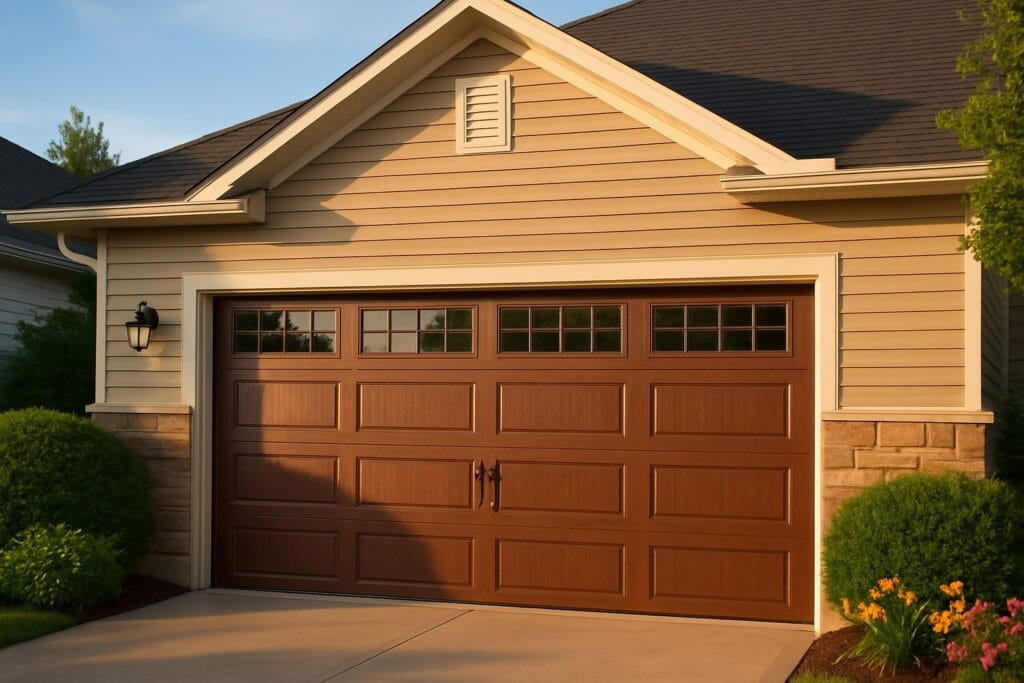Most families in Richmond use the garage as a daily entry to the home. The garage door moves many times each day and keeps vehicles, tools, and belongings safe. When the door is quiet and smooth, it fades into the background, and life feels easy. When it starts to grind, shake, or fail to close, the entire routine is disrupted. This is where consistent care and smart planning make a difference. In simple terms, garage door maintenance protects your time, your safety, and your wallet.
At Oaks Overhead Doors Co., our team has seen how small habits prevent big headaches. A Richmond homeowner recently called us because the door kept bouncing back open. The auto reverse sensors were out of alignment, and a roller had started to crack. A brief inspection, a simple sensor alignment, and a quick roller replacement restored smooth operation and prevented a more serious failure. This is a perfect example of how regular maintenance and fast response turn a frustrating situation into a quick fix.
You do not need to be a technician to understand the basics of your garage door system. With a few preventive steps, well-timed inspections, and a simple checklist, many homeowners can spot early warning signs and avoid emergency garage door repairs. This article explains how maintenance works, why it matters in Richmond weather, what you can do on your own, and when to call a professional garage door service for deeper inspections, adjustments, and replacement parts.
Why Garage Door Maintenance Matters in Richmond, TX
Heat, humidity, and sudden storms are part of life in Fort Bend County. Weather places steady stress on metal parts, seals, and electronics. Humid air encourages rust, while heat causes metal to expand and contract. Heavy rain can push water under the door when weather stripping is brittle or missing. Over time, these conditions wear down springs, rollers, tracks, and opener components.
Regular maintenance controls these risks. Lubrication limits friction on hinges and rollers. Cleaning the tracks keeps dirt and debris from binding movement. Inspection of springs and cables catches problems before a failure damages the opener or causes the door to fall out of balance. Checking the logic board and sensors on the garage door opener confirms that safety systems work as designed. By addressing these items in a steady routine, the entire system stays in good condition and operates smoothly for years.
Local knowledge matters as well. We see corrosion patterns that match seasonal storms. We see weatherstripping that dries out early on doors that face direct sun. We see dirt buildup on tracks in homes close to new construction sites. When we share these patterns with homeowners, they understand the why behind each maintenance task and feel confident about the plan for their door.
Understanding the Garage Door System
A garage door is a coordinated system. When one piece fails, the others feel the strain. Knowing the basic parts helps you follow a maintenance plan with confidence.
Panels and hinges
Panels form the body of the door. Hinges connect panels and allow bending as the door rolls along the track. Loose hinge screws, bent hinges, or cracked panels lead to noisy operation and misalignment. Regular tightening of nuts and bolts and quick replacement of a worn hinge keep the motion smooth.

Tracks and rollers
Tracks guide the door along a precise path. Rollers ride inside the track. Dirt, rust, or dents cause the rollers to bind. Worn rollers wobble and create rough movement. Cleaning with a microfiber cloth and degreaser, followed by targeted lubrication, preserves reliable travel.
Springs and cables
Tension springs carry the weight of the door. Cables attach to the bottom bracket and transfer lifting force. If a spring weakens or a cable frays, the door may slam, hang crooked, or refuse to stay open. Spring and cable inspection is not a do-it-yourself task. These parts are under heavy tension and can cause serious injury. A trained technician should handle adjustments and replacements.
Opener and sensors
The garage door opener provides power and control. Safety sensors create the auto reverse function that protects children, pets, and vehicles. If sensors are dirty or out of alignment, the door will reopen or refuse to close. Regular cleaning with a soft cloth and careful alignment keeps this safety feature reliable.
Weather stripping and seals
Bottom seals and side seals block drafts, water, and pests. In Richmond weather, these seals can harden, crack, or pull away from the track. Fresh weatherstripping improves energy efficiency, keeps the garage cleaner, and reduces moisture that leads to rust.
Common Problems: Good Maintenance Prevents
- Broken springs – When a spring snaps, the door becomes very heavy and may not move at all. Regular inspection reveals rust, gaps in the spring coil, or signs of fatigue. Timely replacement prevents secondary damage to the opener or tracks.
- Worn rollers and rough tracks – A rumbling door that shakes the whole house is often running on flat or cracked rollers. Dirt packed in the track will add to the noise. Cleaning the track and replacing worn rollers restores quiet movement and reduces stress on the opener.
- Misaligned or dirty sensors – When the door closes partway and then opens, sensors may be blocked by dust or slightly out of line. Cleaning the lenses and leveling the sensor brackets will often solve the issue in minutes.
- Loose hardware – Vibration loosens nuts, bolts, and hinge screws over time. A seasonal tightening prevents rattles and keeps the door in alignment.
- Brittle weatherstripping – If light comes through the corners or water blows under the door during storms, the seal has likely failed. New weather stripping protects the floor, lowers energy costs, and discourages pests.
The Benefits of a Regular Maintenance Plan
Safety first
A well-maintained garage door protects your family and your vehicles. Auto reverse sensors stop and reverse the door when they detect an object. Properly adjusted springs and cables balance the weight of the door. These safety systems work best when they are cleaned, aligned, and tested during routine service.
Lower costs over time
Replacing a ten-dollar part at the right time can save a motor or save a track that would cost far more to replace. Regular maintenance prevents costly repairs by catching potential issues early.
Smooth operation and quiet performance
Squeaks, grinding, and rumbling are not normal. They are signs of friction or misalignment. Lubrication and hardware adjustments bring the door back to a calm, steady motion.
Longer equipment life
Springs, rollers, and garage door openers last longer with preventative maintenance. Many homeowners extend the useful life of a door by several years when they follow a consistent schedule.
Energy efficiency and cleaner spaces
Fresh seals keep dust and moisture out and help the connected rooms stay more comfortable. That means a cleaner garage and a small but real improvement in energy efficiency inside the home.
DIY Maintenance Tips for Homeowners
Some basic upkeep is safe and very effective between professional visits. Use this checklist and keep it on your garage wall for quick reference.
Monthly quick check
- Look and listen. Stand inside the garage and watch a full cycle. Note scraping sounds, jerks, or shimmies.
- Wipe the tracks. Use a microfiber cloth to remove dirt. If there is sticky buildup, apply a light degreaser and wipe clean.
- Clean the sensors. Wipe each lens gently and make sure both sensor lights are solid.
Every three months
- Lubricate moving parts. Use a garage door-specific spray lubricant on rollers, hinges, and the spring coil. Avoid soaking the track. A thin film on moving parts is enough.
- Tighten hardware. Gently snug hinge screws, nuts, and bolts. Do not over-tighten.
- Inspect weatherstripping. Look for cracks at the corners and a crushed bottom seal.
Every year
- Test door balance. Pull the emergency release, lift to waist height, and see if the door stays. If it slides up or slams down, contact a professional for spring adjustment.
- Replace the opener battery if your unit has battery backup.
- Review the overall condition. Look for rust on springs, loose cables, and any signs of water intrusion.
Important safety reminders
Do not remove or loosen springs or the center bracket. Do not pull cables off drums. Do not place fingers between panels. If a part looks rusted or cracked or if you suspect a spring problem, call a professional garage door service right away to prevent serious injury.
When to Choose Professional Service Over DIY
A professional brings training, specialized tools, and experience that protect both the door and the homeowner. Call a technician for any of the following situations.
- The door will not open or is stuck halfway.
- A spring has broken or a cable is frayed.
- The opener hums, but the door does not move.
- The door is very heavy to lift by hand.
- The tracks are bent, or the door has come off the track.
- Safety sensors refuse to align or stay lit even after cleaning.
Professional work also comes with a warranty on parts and labor. This adds reliability and peace of mind. A careful tune-up may also reveal hidden issues such as a cracked hinge or a hairline fracture in a roller stem that a glance might miss.
Seasonal Maintenance in Richmond Weather
Spring and early summer
Pollen and dust coat everything, including tracks and sensors. Clean lenses and tracks with a soft cloth. Check the bottom seal for gaps after heavy rain. Heat begins to dry lubricants, so a fresh application during this period helps maintain smooth operation.
Late summer and fall
High heat and sunlight can harden weatherstripping. Inspect the side seals and the bottom seal. Confirm that the door closes with a firm yet gentle seal against the floor. Check the opener light cover for insect nests that can cause overheating.
Winter and early spring
Cooler nights bring condensation and the start of rust on untreated metal. Wipe visible rust and apply lubricant to springs and hinges. Make sure the auto reverse feature works, since people often carry more bulky items in cold months and need an extra safety margin.
A seasonal rhythm simplifies upkeep. Tie your garage door checklist to home events such as changing air filters or testing smoke alarms so it becomes a natural part of household care.
Signs You Need Immediate Service
- Loud grinding that does not improve with lubrication
- The door closes and reopens with no object in the path
- Door drops quickly when released from the opener
- Panels bow or flex more than usual
- A strong burning smell from the opener motor
- Visible rust flakes from springs or red dust near the drums
- A sensor light that will not turn solid after careful cleaning and alignment
If you notice any of these signs, stop using the door and schedule a professional inspection before more serious damage occurs.
Choosing the Right Lubricants and Cleaners
Use a product made for garage doors. Silicone spray or white lithium spray lubricant is are good choice for rollers, hinges, and springs. Wipe off old grease and visible dirt with a microfiber cloth first. If parts are sticky, use a small amount of degreaser, wipe clean, and then apply lubricant lightly. Avoid heavy household oils on tracks because they attract dirt. The track itself should remain mostly clean, with just a thin film at contact points if recommended by the product instructions.
Smart Technology and Garage Door Openers
Modern garage door openers often include connectivity through a mobile app. Features include alerts when the door is left open, remote closing, and schedules that close the door at night for security. These features improve reliability and convenience when used correctly. When researching guides for smart setup, rely on current sources and current browsers, since older guides written for Internet Explorer may be outdated. During maintenance, we can help set travel limits, update opener settings, and test battery backup to keep your system ready during power outages.
Materials, Curb Appeal, and Energy Efficiency
Maintenance habits change slightly with door material. Wood doors need regular sealing to prevent water damage. Steel doors resist impact but can rust if the paint is damaged. Aluminum doors are light and benefit from careful alignment to avoid flex. Composite doors offer strength with low upkeep. No matter the material, clean panels with mild soap and water, rinse well, and dry with a soft cloth.

Fresh weatherstripping keeps conditioned air inside and reduces dust. This small investment protects the garage and connected rooms. A clean and quiet door also improves curb appeal. When it is time for a new door, we help you select panel styles, window layouts, and insulation levels that match the look of your home and your energy goals.
Cost Factors and How Maintenance Controls Expenses
Every repair has two basic cost drivers. Parts cost and labor cost. Preventive maintenance lowers both. Replacing a worn roller or tightening hardware is quick and inexpensive. Allowing a roller to fail can bend a track and overwork the opener, which multiplies costs. Keeping seals fresh prevents water from pooling on the floor, which protects the bottom of wood trim and avoids more expensive restoration. In short, small scheduled services reduce the chance of big unscheduled expenses.
Final Thoughts
Garage door maintenance is a practical habit that keeps your home safe, your routine smooth, and your costs under control. The essential idea is simple. Clean moving parts, keep them lubricated, tighten loose hardware, watch for changes in sound and movement, and schedule professional inspections for high-tension components and deeper system checks. Richmond weather adds heat, humidity, and storms to the picture, so seals and rust control deserve special attention. When you follow a steady plan, the entire system rewards you with reliable performance year after year.
Many homeowners wait until something breaks to think about the garage door. A better path is to treat the door as essential home equipment. Place maintenance tasks on the calendar, keep a small supply of spray lubricant and a soft cloth on a shelf near the door, and teach every driver in the home how to recognize early signs, such as unusual noise or slow travel. If you see frayed cables, a heavy door, or a spring concern, stop and call for professional service right away. These steps prevent serious injury, avoid costly repairs, and protect the value of your home.
When you want added peace of mind, partner with a local garage door expert who understands Richmond conditions, common issues, and the best solutions for long-term reliability. Our team is ready to help you build a simple plan that keeps your door opener and all related parts in good condition for years to come.
How Can Oaks Overhead Doors Co. Help You?
At Oaks Overhead Doors Co., we provide complete care for residential and commercial garage doors. Our maintenance visits include a full inspection of springs, cables, rollers, tracks, hinges, sensors, and the opener. We clean and lubricate moving parts, tighten hardware, align safety sensors, adjust travel limits, and replace worn weatherstripping to protect your garage from dust and moisture. If we find a part that needs replacement, we explain the options clearly and complete the repair with quality parts so your door returns to smooth operation.
If you are facing an urgent problem such as broken springs, a door off the track, or an opener that will not run, our emergency repairs restore safety and function quickly. If you are planning upgrades, we also install new garage door openers with modern features, and we help you select a new door that improves curb appeal and energy efficiency.
📍 Visit us at: 7119 FM 1464, Richmond, TX 77407, United States
📞 Call us today at: (281) 572 5318
Reach out now to schedule a regular garage door maintenance visit or to request expert advice for a specific issue. We look forward to keeping your garage door system safe, quiet, and reliable.
Frequently Asked Questions (FAQs)
1. How often should garage door springs be replaced?
Garage door springs typically last between seven to ten years, depending on how often the door is used. If you notice gaps in the coils, rust, or difficulty lifting the door, it is time to schedule a replacement.
2. Can garage doors be painted to match my home’s exterior?
Yes, most garage doors can be painted with high-quality exterior paint to improve curb appeal. Be sure to clean the surface thoroughly, remove any rust, and use a primer if needed before applying the paint.
3. What is the average lifespan of a garage door opener?
A garage door opener usually lasts 10 to 15 years with proper maintenance. Lifespan can be extended by keeping the system lubricated, aligned, and free of debris.
4. Are insulated garage doors worth the investment in Richmond, TX?
Yes, insulated garage doors help regulate the temperature inside the garage, which can reduce energy costs for connected living spaces. They also improve noise reduction and add durability to the door.

